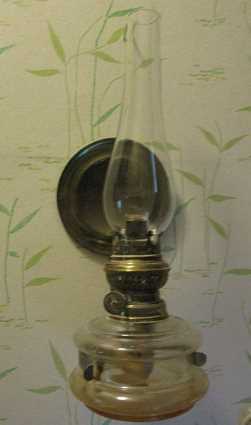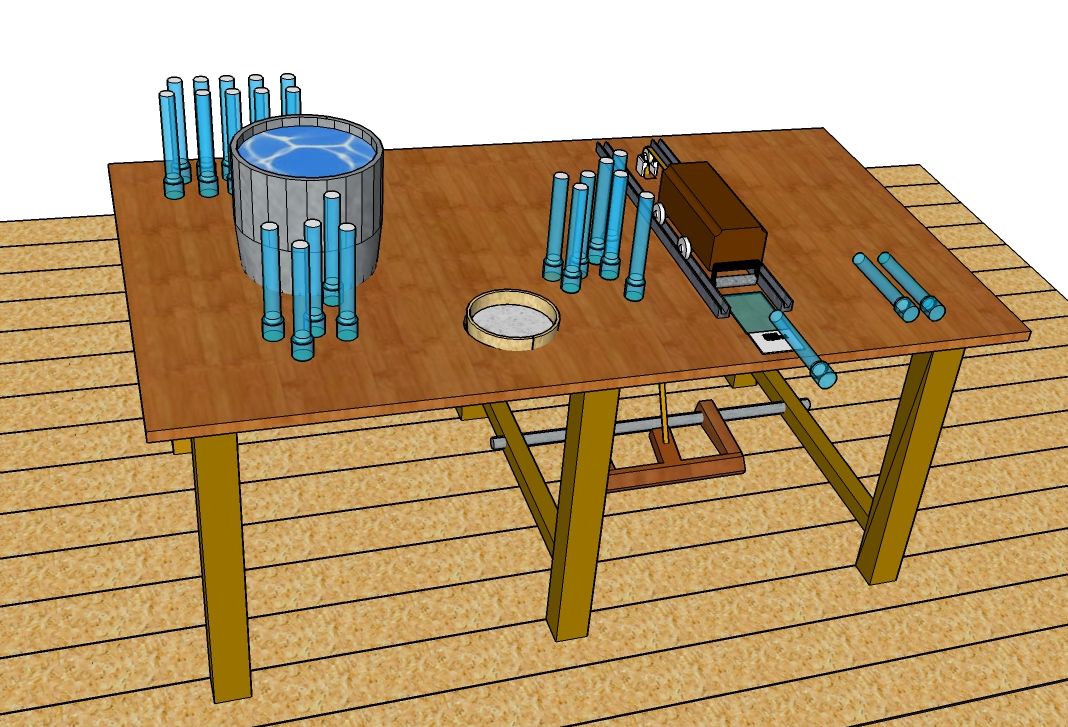The text is difficult to translate, but here is my best try (the Swedish original below):
"
[…]to the stamp workshop. The team consisted of three people, one stamped, one salted, one wrapped the
chimneys in tissue paper. […]
Across the workbench there were two pieces of narrow iron rails mounted, about eight centimetres apart. On these rails there
was a wooden piece fitted with four wheels. This wooden piece, which we children called the train, was about twenty-five cm long
and eight centimetres tall. The train ran back and forth by having a leather strap at the end of the rails down through a hole in
the workbench. The strap was attached to a wooden treadle, which was stepped up and down during work. At the front and bottom of
the train a rubber roller was mounted. This roller was the most important part of the stamp machine. The role of the roller was to
coat the rubber stamp, which was glued to a wooden board between the tracks at the front and near the edge of the bench. Just
behind the stamp was a glass plate fixed between the rails. The glass plate was sprinkled occasionally with stamp coating,
which was prepared by [my] father himself and was seen as a factory secret. The worker stamping the glass
took a chimney with his right hand, and at the same time he activated the treadle, which made the rubber roller pass the stamp
and the coating plate. He placed the glass behind and over the stamp plate with the tip of the glass about a centimeter from the stamp.
He pressed lightly with the fingers of both hands while rolling the chimney over the stamp. With the right hand a new glass was taken
from the right side while the pedal under the bench was let up, which made the the machine with the roller return over the plate
with the coating and the rubber stamp. The pedal was then pushed down again.
To the left of the stamp machine was a hole in the bench. In this hole a ceramic pot was halfway submerged, and in the pot there
was a white powder called salt. In fact, this was powdered hydrofluoric acid and used to etch the stamp into the glass. Under the pot
a small oil lamp was placed and when the salt started to get damp, the lamp was lit. The lamp heated the bottom of the pot and when
the contents became dry and volatile and threatened to rise in the air and in the nose of the salter, the lamp was turned off
for a while.
The salting work proceeded as follows. The worker took the glasses that was on the right hand side with his left hand, holding
them with the stamped narrow end over the salt cup, taking the brush that lay in the salt cup and sprinkling some salt all over
the stamp. After that, he took a small brush and carefully wiped the remaining powder back into the salt cup. He always made three
strokes, one from the right, one from the left and one from the middle of the stamp; this in order that if any of the fluoride salt
remained at the side of the stamp, the glass was etched there too and would then have to be discarded. After a few minutes, the time
could vary slightly if the air was dry or damp, he took the salted glasses and dipped them in a water tank beside, where
the fluoride salt was rinsed off and the stamp was revealed white and indestructable on the clear surface.
"
Here is the Swedish original text:
"
[…] till stämpelverkstaden. Arbetet försiggick där i verkstäder på tre personer, en som stämplade, en som saltade, en som
invecklade glasen i silkespapper. […]
Tvärs över arbetsbänken fanns två styck smala järnskenor monterade, cirka åtta centimeter från varandra. På dessa skenor fanns ett
trästycke utrustat med fyra hjul. Detta trästycke, som vi barn kallade tåg, var ungefär tjugofem cm långt och åtta cm högt. Tåget
löpte fram och åter genom att det baktill hade en läderrem som vid slutet av skenorna gick ned genom ett hål i arbetsbänken. Remmen
var nedtill fästad i en trätrampa, som trampades upp och ned under arbetet. Längst fram och ned på tåget var en gummirulle anbringad.
Denna rulle var den viktigaste detaljen i stämpelmaskinen. Rullens uppgift var nämligen att smörja gummistämpeln, som var
fastklistrad på en träskiva mellan spåren längst fram och nära kanten på bänken. Strax bakom stämpeln var på samma sätt en glasskiva
fastsatt mellan spåren. Glasskivan beströks någon gång emellanåt med stämpelsmörja, som tillagades egenhändigt av far och var
en s k fabrikshemlighet. Den som nu stämplade glasen tog med höger hand från höger sida ett glas, och samtidigt som han med foten
trampade tillbaka maskinen, varvid gummirullen passerade stämpeln och färgskivan, placerade han glaset bakom och över stämpelskivan
med lilländen av glaset ungefär en centimeter från stämpeln. Han tryckte lätt med båda händernas fingrar på glaset, medan det
rullades över stämpelskivan. Med höger hand togs ett nytt glas från höger sida samtidigt som foten släppte efter på trampan under
bänken, varvid maskinen med färgrullen gick tillbaka över färgskivan och gummistämpeln. Trampan trycktes så åter ned o s v.
Till vänster om stämpelmaskinen var ett cirka femton centimeter runt hål uppsågat i bänken. I detta hål var en keramikkarott nedsänkt
till hälften och i karotten fanns ett vitt pulver som benämndes för salt. Detta var i själva verket pulvriserad fluorvätesyra och
användes till att etsa in stämpeln i glaset. Inunder lerkarotten var en liten oljelampa placerad och när saltet började bli fuktigt,
så tändes lampan. Lågan värmde då upp botten på karotten och när innehållet åter blev torrt och flyktigt och hotade att stiga upp i
luften och i näsan på den som saltade glasen, så släcktes åter lampan för en stund.
Arbetet med saltningen till gick på följande sätt. Man tog glasen som låg till höger med vänster hand, höll dem så med den stämplade
lilländen över saltkoppen, tog penseln som låg i saltkoppen och strödde lite salt över hela stämpeln. Därefter tog man en liten
moddlare och strök försiktigt av det överblivna pulvret åter ned i saltkoppen. Men gjorde alltid tre strykningar, en från höger,
en från vänster och en från mitten på stämpeln; detta för att om något av fluorsaltet fick vara kvar vid sidan av stämpeln,
så blev glaset etsat även där och kunde då bliva kasserat. Efter några minuter, tiden kunde variera något på grund av om luften
var torr eller fuktig, tog man de saltade glasen och doppade ner dem i en vattenbehållare vid sidan om, varvid fluorvätesaltet
sköljdes bort och stämpeln avtecknades vit och oförstörbar mot den klara ytan.
"



